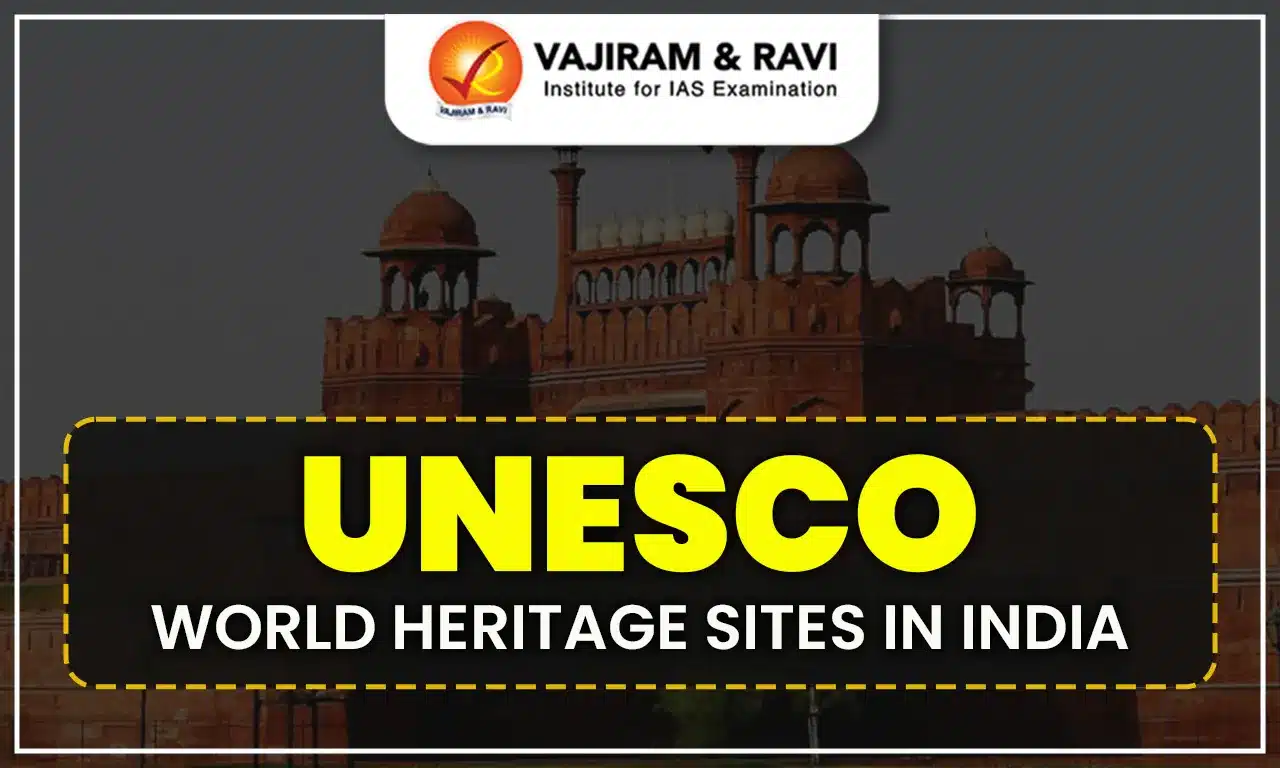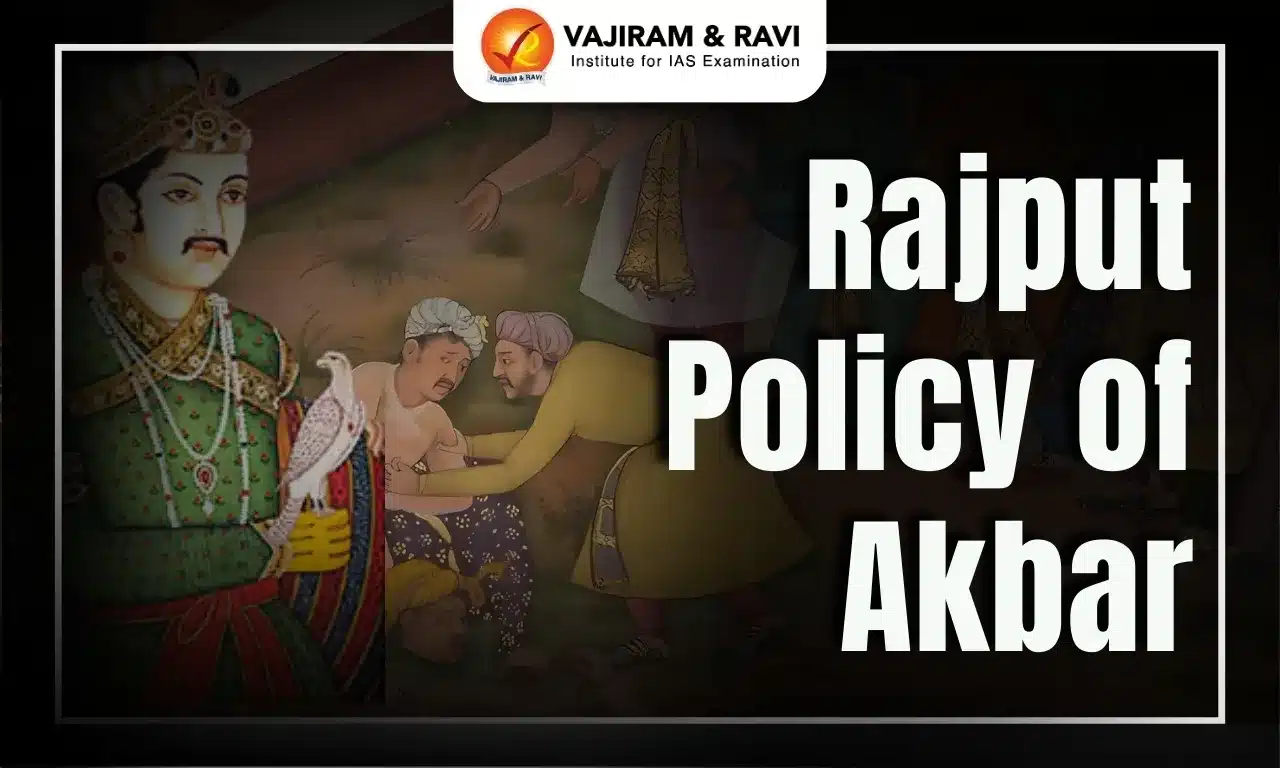UNESCO World Heritage Sites are landmark places recognised by the United Nations Educational, Scientific and Cultural Organisation for their cultural, historical, or natural significance. These sites are selected based on their outstanding value to humanity, ensuring their preservation for future generations. India has been blessed with a rich history and natural diversity, which is exemplified by its 43 UNESCO World Heritage Sites (May 2025). These include 35 Cultural sites, 7 Natural sites and 1 mixed site recognised for their outstanding universal value to humanity.
From ancient monuments to pristine forests, India’s World Heritage Sites encapsulate the essence of incredible India. Sites like the Taj Mahal, Ajanta Caves, Western Ghats and Sundarbans National Park are inscribed for their universal value. Understanding and preserving these treasures is crucial for safeguarding India’s heritage for future generations.
UNESCO World Heritage Sites About
UNESCO World Heritage Sites are landmarks or areas recognised for their outstanding cultural, historical, or natural significance and are protected under an international treaty administered by UNESCO. The selection process is rigorous, ensuring only the most outstanding sites are included.
- These sites can include ancient ruins, monuments, buildings, cities, forests, mountains, or wilderness areas that represent the shared heritage of humanity.
- As of May 2025, there are 1,223 World Heritage Sites across 168 countries, selected for their universal value and preserved for future generations.
- Famous examples include the Great Barrier Reef in Australia, the Pyramids of Egypt, and the Serengeti National Park in Tanzania.
- India, with its rich history, is home to several UNESCO World Heritage Sites, including the Taj Mahal, Ajanta Caves, and Sundarbans National Park.
UNESCO World Heritage Sites Background
The concept of World Heritage emerged after World War 2 amid concerns over the widespread destruction of cultural sites and nature. Efforts to remedy this led to the drafting of the 1972 Convention Concerning the Protection of the World Cultural and Natural Heritage, commonly known as the World Heritage Convention. It established the framework to preserve the world's outstanding heritage.
- The Convention defines the kind of natural or cultural sites that can be considered for inscription on the World Heritage List by meeting specified criteria.
- By signing the Convention, member countries commit to protecting not just national heritage but mankind's shared heritage, irrespective of where sites are located.
- India formally signed the Convention on November 14, 1977.
UNESCO World Heritage Convention
UNESCO World Heritage Convention, formally known as the Convention Concerning the Protection of the World Cultural and Natural Heritage, was adopted in 1972 and came into force in 1975. The Convention's primary objective is to identify, protect, and preserve sites of outstanding universal value, ensuring their transmission to future generations.
- It establishes the World Heritage Committee and List. Sites nominated by states are evaluated by designated advisory bodies before being inscribed on the list.
- Signatory countries commit to safeguarding these sites, integrating heritage protection into national planning, and reporting on their conservation status.
- The Convention also facilitates international cooperation and assistance, providing support through the World Heritage Fund for preservation efforts.
- The Convention thus created a framework of international cooperation and legal obligations to preserve humanity's shared heritage.
UNESCO World Heritage Site Selection Criteria
UNESCO World Heritage Site selection criteria are a set of ten standards used to determine whether a site has Outstanding Universal Value and deserves global recognition and protection. To qualify, a site must meet at least one of these criteria, which cover both cultural and natural significance. The International Council on Monuments and Sites (ICOMOS) and the International Union for Conservation of Nature (IUCN) assess each nominated site.
To assess Outstanding Universal Value (OUV), sites must meet at least one of the ten criteria.
Cultural Sites (6 criteria):
- A masterpiece of human creative genius.
- Represents cultural interchange or a civilisation.
- Bears unique testimony to a tradition or civilisation.
- Exemplifies architecture, technology, or landscape.
- Shows traditional settlement, land, or sea use.
- Links to events or ideas of universal significance.
Natural Sites (4 criteria):
- Displays superlative natural phenomena or features.
- Represents Earth's evolutionary history.
- Exemplifies ecological and biological processes.
- Hosts critical habitats of biological diversity.
World Heritage Sites Legal Status
Once inscribed, World Heritage Sites remain under the sovereignty of their respective states, but their protection becomes a collective responsibility. Key legal implications include:
- State Obligations: Identify, protect, conserve, and transmit cultural and natural heritage to future generations.
- Integration: Incorporate heritage protection into regional planning and avoid actions that harm heritage.
- Reporting & Education: Periodically report site conditions and promote heritage appreciation through education.
- International Support: The World Heritage Committee can assist with threats, impose sanctions, or delist endangered sites.
States retain ownership but share the responsibility to preserve heritage for all humanity, even at the cost of limiting certain activities.
UNESCO World Heritage Sites India
UNESCO World Heritage Sites in India include 43 remarkable locations recognised for their cultural, natural, or mixed significance. Among these, 35 are cultural sites, 7 are natural, and 1 is a mixed site. Notable examples encompass the Taj Mahal, Ajanta and Ellora Caves, Sun Temple at Konark, Kaziranga National Park, and the Western Ghats. These sites reflect India's rich historical legacy, architectural brilliance, and ecological diversity. India ranks sixth globally in the number of World Heritage Sites, underscoring its commitment to preserving its diverse heritage.
UNESCO Cultural World Heritage Sites in India
UNESCO Cultural World Heritage Sites in India include iconic monuments like the Taj Mahal, Ajanta and Ellora Caves, and the Sun Temple at Konârak. These sites reflect India's rich historical, architectural, and cultural legacy. Here is a table outlining key facts about India's 35 UNESCO (May 2025) World Heritage cultural sites:
| Site (Included in UNESCO’s list) | Location | Significance |
| Agra Fort (1983) | Uttar Pradesh | - Palace fort with a crucial history of the Mughal Empire |
| Ajanta Caves (1983) | Maharashtra | - Finest surviving examples of ancient Buddhist cave paintings and rock-cut architecture |
| Ellora Caves (1983) | Maharashtra | - Outstanding crystallization of ancient Indian rock-cut architecture representing Buddhist, Hindu and Jain faiths |
| Taj Mahal (1983) | Uttar Pradesh | - Architectural masterpiece of the Mughal era |
| Sun Temple, Konark (1984) | Odisha | - 13th-century temple extolling the Sun God Surya in unique architectural style and elaborate stone carvings |
| Group of Monuments at Mahabalipuram (1984) | Tamil Nadu | - 7th-8th century architectural and sculptural evolution in the port city of the Pallava dynasty |
| Churches and Convents of Goa (1986) | Goa | - Remnants of Portuguese colonial architecture and Christianity's expansion in Asia |
| Fatehpur Sikri (1986) | Uttar Pradesh | - Imperial capital city built by Mughal Emperor Akbar in 16th century, blending Indo-Islamic architecture styles |
| Group of Monuments at Hampi (1986) | Karnataka | - Capital city of Vijayanagara empire in 14th-16th century with brilliant temple architecture |
| Khajuraho Group of Monuments (1986) | Madhya Pradesh | - Clusters of Hindu and Jain temples built in 10th-11th century CE renowned for erotic sculptures of dancers and couples |
| Elephanta Caves (1987) | Maharashtra | - Rock-cut cave shrines of Shiva sect from 6th century CE with monumental sculpture |
| Great Living Chola Temples (1987, 2004) | Tamil Nadu | - 11th and 12th century Chola dynasty temple complexes demonstrating evolution of form and architecture |
| Group of Monuments at Pattadakal (1987) | Karnataka | - 8th century CE Chalukya dynasty temple exemplifying blend of Northern and Southern styles |
| Buddhist Monuments at Sanchi (1989) | Madhya Pradesh | - Oldest stone structures extant from 3rd century BCE preserving core of Buddhist art and architecture |
|
Humayun's Tomb (1993) |
Delhi | - Mughal tomb which is earliest Garden-tomb on the Indian subcontinent, precursor to Taj Mahal |
| Qutb Minar and its Monuments (1993) | Delhi | - 13th-century minaret and monuments complex built by Qutubuddin Aibak heralding Indo-Islamic architecture |
| Mountain Railways of Darjeeling, Kalka Shimla & Nilgiri (1999) | West Bengal |
- Opened between 1881 and 1908, these hill railways exemplify bold engineering solutions for connecting mountainous terrains. - Fully operational, they showcase the ingenuity of late 19th and early 20th-century engineering. |
| Rock Shelters of Bhimbetka (2003) | Madhya Pradesh | - Site demonstrating early human life through traces of prehistoric rock paintings dating 30,000 years ago. |
| Champaner-Pavagadh Archaeological Park (2004) | Gujarat | - Pre-Mughal Islamic city and fort from the 8th to 14th centuries CE. |
| Chhatrapati Shivaji Terminus (2004) | Maharashtra |
- It was designed by Frederick William Stevens in the Victorian Gothic style, drawing influences from Italian Gothic architecture and combining them with influences from Indian traditional buildings built in the late 19th century. - It symbolised the wealth of Mumbai as a major commercial port within the British Commonwealth. |
|
Red Fort Complex (2007) |
Delhi | - Monumental 17th-century Mughal palace fort built when the empire was at its artistic zenith |
| The Jantar Mantar, Jaipur (2010) | Rajasthan | - 18th-century astronomical observation site demonstrating empire's scientific advancement |
|
Hill Forts of Rajasthan (2014) |
Rajasthan | - Massive hill forts in Rajasthan demonstrating the power of Rajput kingdoms |
| Rani Ki Vav (Queen's Stepwell), Patan (2014) | Gujarat | - Elaborately sculpted 11th century AD stepwell demonstrating mastery of engineering |
| Archaeological Site of Nalanda Mahavihara (2016) | Bihar | - Archeological remnants of the ancient seat of Mahayana Buddhism and monastic learning in India |
| The Architectural Work of Le Corbusier, (2016) | Chandigarh |
- An Outstanding Contribution to the Modern Movement is a World Heritage Site consisting of a selection of 17 building projects in several countries by the Franco-Swiss architect Le Corbusier. - These sites demonstrate how Modern Movement architecture was applied to respond to the needs of society and show the global range of a style and an architect. |
| Historic City of Ahmedabad (2017) | Gujarat | - World Heritage City founded in 15th-century exhibiting unique architectural styles |
| Victorian Gothic and Art Deco Ensemble of Mumbai (2018) | Maharashtra | - 19th and 20th-century Gothic revival and Art Deco architectural creations in the growing port city |
|
Jaipur City, Rajasthan (2019) |
Rajasthan | - 18th century planned city founded as the capital of Amber kingdom exemplifying city planning and architecture |
| Dholavira: A Harappan City (2020) | Gujarat | - One of the largest and most prominent cities of the ancient Indus Valley Civilisation dating 4000-1500 BCE |
| Kakatiya Rudreshwara (Ramappa) Temple (2021) | Telangana | - 13th-century engineering masterpiece of Kakatiya dynasty with splendid ornate architecture and sculptural workmanship |
| Santiniketan (2023) | West Bengal | - It is the cultural and educational centre established by Nobel laureate Rabindranath Tagore. |
| The Sacred Ensembles of the Hoysala (2023) | Karnataka |
- The famed Hoysala temples of Belur, Halebid and Somananthpura in Karnataka were constructed during the 12th and 13th centuries. - Hoysala temples maintain a fundamental Dravidian morphology,
|
| Modiams (2024) | Assam | A 700-year-old burial mounds of the Ahom dynasty in Assam, marking first cultural site from northeastern state. |
UNESCO Natural World Heritage Sites in India
UNESCO Natural World Heritage Sites in India include seven exceptional locations recognised for their outstanding natural value. Each site showcases unique biodiversity and ecosystems, contributing significantly to global natural heritage. Here is a table of India's 7 UNESCO (May 2025) World Heritage natural sites:
| Site | Location | Significance |
| Kaziranga National Park (1985) | Assam | - Home of the world's largest population of one-horned rhinoceros |
| Keoladeo National Park (1985) | Rajasthan | - Important man-made wetland providing refuge to migratory waterbirds |
| Manas Wildlife Sanctuary (1985) | Assam | - Critical tiger habitat representing biodiversity of Eastern Himalayas |
| Sundarbans National Park (1987) | West Bengal | - Largest estuarine mangrove forest globally endangered by rising sea levels |
| Nanda Devi and Valley of Flowers National Parks (1988, 2005) | Uttarakhand | - Contrasting alpine wildflower meadow and rugged glacial wilderness protecting diverse flora and fauna |
| Western Ghats (2012) | Karnataka, Kerala, Tamil Nadu, Maharashtra | - Mountain range running parallel to western coast recognized for high endemism and biodiversity |
| Great Himalayan National Park (2014) | Himachal Pradesh | - Diverse ecosystems and biodiversity of the Great Himalayas, including glaciers, alpine meadows and forest wildlife |
UNESCO Mixed World Heritage Sites
UNESCO Mixed World Heritage Sites in India include Khangchendzonga National Park in Sikkim, designated in 2016 for its combined natural beauty and cultural significance. It is the only UNESCO World Heritage mixed site in India (May 2025):
| Site | Location | Cultural Significance | Natural Significance |
| Khangchendzonga National Park- (2016) | Sikkim | - Associated with indigenous Sikkimese culture and the sacred meaning of the mountain peak | - Protects a huge range of eastern Himalayan biodiversity across different vegetation zones from subtropical to alpine meadows |
UNESCO World Heritage Sites in India Recent Updates
In 2025, six significant sites from India were added to UNESCO’s Tentative List, an essential step before any site can be nominated for the prestigious World Heritage status. This inclusion brings the total number of sites on India's tentative list to 62. The newly added sites are:
- Kanger Valley National Park (Chhattisgarh): A biodiversity hotspot known for its dense forests and limestone caves, home to rare species like the Bastar Hill Myna.
- Mudumal Megalithic Menhirs (Telangana): Ancient standing stone structures dating back to the Iron Age, believed to be burial markers or commemorative monuments.
- Ashokan Edict Sites along the Mauryan Routes: Inscriptions by Emperor Ashoka carved on pillars and rocks to propagate Buddhist teachings and ethical governance.
- Chausath Yogini Temples (Multiple States): A series of 64 temples dedicated to the goddess Durga, showcasing unique architectural styles across various locations.
- Gupta Temples in North India: Ancient temples from the Gupta period, reflecting the golden age of Indian architecture and sculpture.
- Palace-Fortresses of the Bundelas (Madhya Pradesh and Uttar Pradesh): Majestic structures blending Rajput and Mughal architectural styles, illustrating the grandeur of the Bundela dynasty.
UNESCO World Heritage Sites UPSC PYQs
Q1. Consider the following properties included in the World Heritage List released by UNESCO: (UPSC Prelims 2024)
1. Shantiniketan
2. Rani-ki-Vav
3. Sacred Ensembles of the Hoysalas
4. Mahabodhi Temple Complex at Bodhgaya
How many of the above properties were included in 2023?
(a) Only one
(b) Only two
(c) Only three
(d) All four
Ans: (b)
Last updated on January, 2026
→ Check out the latest UPSC Syllabus 2026 here.
→ Join Vajiram & Ravi’s Interview Guidance Programme for expert help to crack your final UPSC stage.
→ UPSC Mains Result 2025 is now out.
→ UPSC Notification 2026 Postponed for CSE & IFS which was scheduled to be released on 14 January 2026.
→ UPSC Calendar 2026 has been released.
→ UPSC Prelims 2026 will be conducted on 24th May, 2026 & UPSC Mains 2026 will be conducted on 21st August 2026.
→ The UPSC Selection Process is of 3 stages-Prelims, Mains and Interview.
→ Prepare effectively with Vajiram & Ravi’s UPSC Prelims Test Series 2026 featuring full-length mock tests, detailed solutions, and performance analysis.
→ Enroll in Vajiram & Ravi’s UPSC Mains Test Series 2026 for structured answer writing practice, expert evaluation, and exam-oriented feedback.
→ Join Vajiram & Ravi’s Best UPSC Mentorship Program for personalized guidance, strategy planning, and one-to-one support from experienced mentors.
→ UPSC Result 2024 is released with latest UPSC Marksheet 2024. Check Now!
→ UPSC Toppers List 2024 is released now. Shakti Dubey is UPSC AIR 1 2024 Topper.
→ Also check Best UPSC Coaching in India
UNSECO World Heritage Sites in India FAQs
Q1. How many UNESCO World Heritage Sites are in India?+
Q2. Which is the 43rd UNESCO World Heritage Site in India?+
Q3. Which is the 42nd UNESCO World Heritage Site in India?+
Q4. Which is the 41st UNESCO heritage site in India?+
Q5. What is the rank of India in UNESCO?+

















